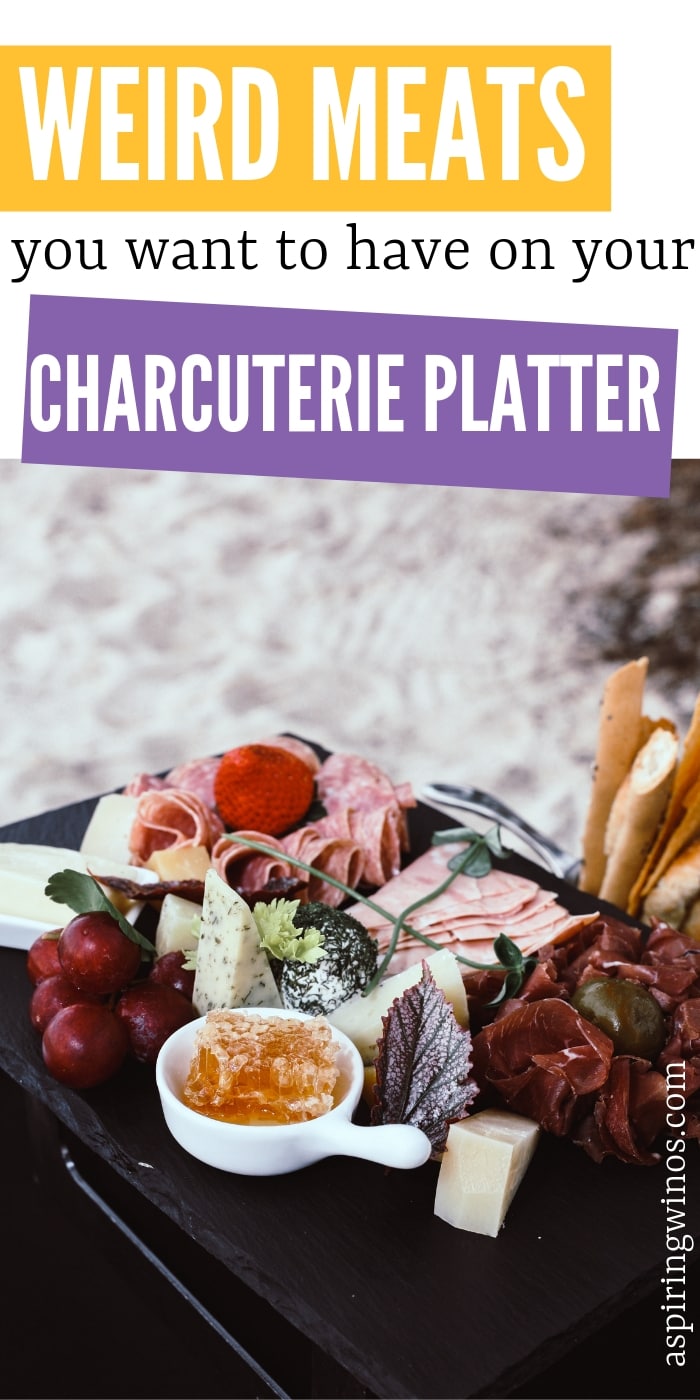Disclosure of Material Connection: Some of the links in the post above are "affiliate links." This means if you click on the link and purchase the item, I will receive an affiliate commission. Regardless, I only recommend products or services I use personally and believe will add value to my readers. I am disclosing this in accordance with the Federal Trade Commission's 16 CFR, Part 255: "Guides Concerning the Use of Endorsements and Testimonials in Advertising."
Smoked, cured and seasoned, these meats grace any decent charcuterie platter. These are the weird meats you absolutely want on your charcuterie platter. We don’t really do snobby here, and we’d never turn down a piece of pepperoni on a club cracker. That being said, the finer things in life are often very much more refined. Enjoyed for centuries, these deeply savory and succulent delicacies are to die for. Load up your favorite extra-large charcuterie tray with an assortment of these… and see if you get thumbs up or wrinkled faces from your friends.

Related: Have a look at our 20 must-have charcuterie accessories for making memorable spreads!
Some Weird Meats you Absolutely Want on your Charcuterie Platter
Often snubbed as ‘weird’ for their method of curing, a particular cut of meat or presentation, these slices are not to be overlooked. Platters the world over celebrate wine and the people who drink it with visually stimulating feasts, exploring flavors carefully curated and brought to life on cheese boards since wine drinking became a thing.
For as long as humans have consumed meat, a long time, they’ve found creative ways to prepare and preserve the meat for future consumption. Rather accidentally, this became one of the earliest forms of cuisine. Through the process of salt curing, smoking, wrapping and storing these cuts of meat, we’ve developed highly sophisticated methods that bring the flavor of the cut to life. You might not find all of these at your local grocer, but do some digging and you might just find out that they’re a bit closer to home than you once thought.
We’ll explore a few of them and figure out where they belong on your cheeseboard, as well as the styles in which you can find them prepared. Let’s jump into some fancy words and get you talking like a real connoisseur.
Pate
Your run of the mill pate is essentially a meat paste. That might not be the most appetizing description but they’re perhaps one of the most versatile and easy to serve crowd-pleasers out there. The name as you might have guessed is French in origin. The basic anatomy of pate is some kind of ground forcemeat (a mixture of ground meat and fats) along with some herbs, depending of course on its origin. Try pate made from liverwurst with garlic and herbs!
Terrine
Well, technically it’s also a pate. Terrine’s preparation sets it apart. Baked in a dish lined with puff pastry, sometimes with gelatin, the terrine is an elegant and highly presentable spread centerpiece. Expect this lovely loaf to be the talk of the table.
Rillettes
Fancy pulled pork. Okay, okay it’s not quite so simple! That being said, rillettes is the somewhat less processed and rustic version of their paste based comrades. It doesn’t have to be made from pork, but most are. The fat renders deep savory tastes which is accompanied ever so lovingly, by a texture that is to die for! Melt in your mouth and baguette’s best friend, this dish is not to be overlooked. (Also, it’s not hard to put together!)
Head Cheese
Your ritz crackers and Velveeta have nothing on this fancy classic. Head cheese, made from calf or pig head, is the marriage of collagen, fat, and flavor. So, what does head cheese taste like? Very simply, it’s a cold cut made from cooking usually pig head, the meat of which is tender, flaky and unbelievably flavorful. It is then cooled and stuffed where the collagen and fat take shape to make a sliceable loaf, sausage or whatever else you form it into. While head cheese is not for everyone, (especially the cooking process!), it’s certainly something you should try at least once.
Foie Gras
We understand that foie is not for everyone. We’re just here to discuss its role as charcuterie meat.
Foie Gras is just that, very fatty duck liver. It can come from duck or goose, but you’re most likely to find it from a duck. Foie Gras comes as pate, mousse, and sliced. You can find it in any of these varieties on the charcuterie platter, and the place it holds is valuable for the tasting experience.
It can complement both cheese and herb bread or crackers. It is pale in color and provides a notably rich and succulent taste. It’s considered a well-loved delicacy in France. The Torchon variation (french for tea towel) is wrapped in towel or cheesecloth before being poached in water into usually a cylindrical shape which is how it’s served. The process takes days, which involves cooling, and resting.
White wines are traditionally the favorite of foie gras fanatics. If you’d really like to hone in on the rich taste with some rich bubbly, pair a bottle of champagne to tie it all together. The crisp taste of a nice brut, along with expertly prepared foie gras is a snack as opulent as they come.
Give these Weird Meats a Chance!
Loaves, slices, and spreads. These meats deserve a fighting chance on your next charcuterie spread. Cultured concoctions like these really live up to their reputation. Next time you’re at your local grocer, give one of these a serious try. Or, look up one of the many recipes available out there for your next wine and cheese! Use poultry, pork, beef or even seafood! Unique meat preparations make all the difference on a charcuterie. The serving possibilities and pairings one could drum up are as boundless as these meats are savory. Break out these weird meats you absolutely want on your charcuterie platter.
Also, check out these articles, to host the best-ever weird meat night:
- Must-Make Artichoke Recipes for Your Next Wine Tasting Party
- The Most Delicious Jelly Recipes for Your Cheese Board






